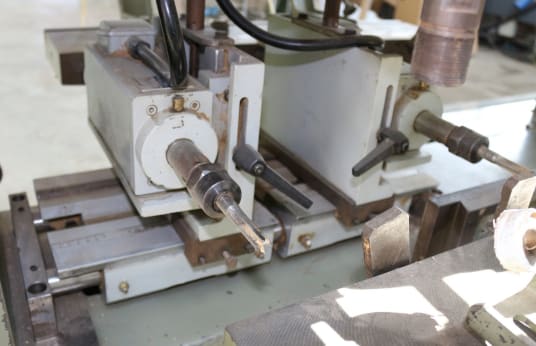A mortising machine is a specialized woodworking tool used for cutting square or rectangular mortises, or recesses, into wood. They are generally electrically powered and operate by lowering the cutting mechanism onto a workpiece secured to a work surface, much like a drill press. In fact, rather than purchase a dedicated mortising machine, some woodworkers buy or make special mortising jigs to use with their drill presses. The key feature of a mortising machine that differentiates it from a drill press is that it squares the corners of the holes cut. Therefore, a mortising machine might also be used to cut a square-edged hole through a workpiece.

Mortising unit Rotation speed 0 rpm Standard drill bit diameter 10 mm o 3/8” Numerical control tenoning and mortising machine. It can perform: - Miter door, a 45° tenon-mortise slot joint - French Joint, a 90° tenon-mortise slot joint. Ideal for kitchen doors. 7 balestrini sectorial machines 6. Multi-Tools Cordless. In Stock Mortising Machine with XY Table and Stand (G0840). 99 Check Stock Horizontal Slot Mortiser (G0846) 3 $ 750. Mortising bits used on solid wood, wood composites or any other similar material. These mortising bits can guarantee high performances on different machines with excellent results. You can either buy mortising bits singularly or in practical and strong plastic bit sets.

The straight sides and square corners of the cuts that characterize a mortising machine are made by a combination of two cutting tools, one a spinning bit and one a very sharp four-cornered hollow chisel. The bit works inside the chisel with just enough clearance to allow sawdust to escape. When the operator lowers the bit assembly onto the workpiece, the drill bit enters the workpiece first, removing the bulk of the stock, so that the chisel has only a small amount of stock to remove.
Multi Slot Mortising Machine Pdf Download
Horizontal mortising machines operate in much the same manner, except that the cutting edges are aligned horizontally. A horizontal mortising machine is especially useful for cutting mortises in larger workpieces and also for drilling mortise-and-tenon cuts. Chain mortise machines are larger mortisers that utilize a cutting chain, much like that found on a chainsaw, to cut mortises into larger workpieces, usually for timber frame construction.
Delta Mortising Machine
Shallow mortises are cut to accommodate such things as hinges, strike plates and other functional and decorative inserts into doors and windows. These mortises are cut just deep enough to ensure that the hardware is flush with the wood's surface when installed. Deeper mortises are cut to create mortise-and-tenon joints. These joints are made by cutting a mortise into one piece of wood and cutting the end of another piece — the tenon — to fit snugly into the mortise. The joint created is secured with carpenter's glue and clamped. There are many different types of mortise-and-tenon joints; all are cut more easily with mortise machines.
Horizontal Slot Mortiser
Mortising machines are of limited utility for hobbyists, which is why they will rarely be found in a hobbyist's workshop. A hobbyist generally cuts the bulk of a mortise with a standard drill press or a router, and the sides and corners will be trimmed with conventional wood chisels. These mortises will usually be of a quality similar to that produced by a mortising machine, but will take much longer. For the professional woodworker, though, for whom time equals money, a mortising machine is an essential component of a woodworking shop.